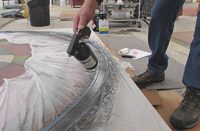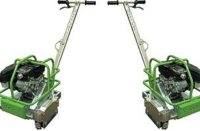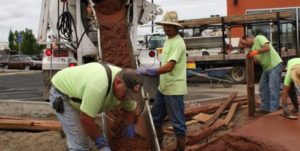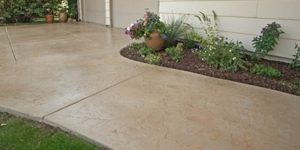 When raw soil or aggregate needs to be compacted before a pour, what do decorative concrete contractors use to pound the ground?
When raw soil or aggregate needs to be compacted before a pour, what do decorative concrete contractors use to pound the ground?
Rollers are too much machine for smaller jobs. So generally, the choice is between rammers and vibratory plate compactors.
The most important factor in making that choice is the type of soil to be compacted. A rammer, which uses a piston set and springs to generate force, works best on cohesive soils, which are composed of clay and silts. Vibratory plates, on the other hand, are low-amplitude, high-frequency machines. They are most effective compacting granular soils, which are made up of sand and gravel.
The particles in cohesive soil are small and densely packed. When dry, it’s hard, and when moist, it’s plastic and easily molded. A rammer’s forceful strokes are ideal when working this kind of ground. “Clay sticks together, and the ramming motion of the equipment forces air out of the soil,” says Peter Cannon, spokesman for Multiquip Inc.
 Granular soil doesn’t cling to itself like cohesive soil does, so the vibrations of a plate compactor do the job just fine. “The vibration action reduces the frictional forces at the contact surface, allowing particles to fall freely under their own weight,” explains Jay Baudhuin, compaction product manager at Wacker Corp. “At the same time, as the soil particles are vibrating, they become momentarily separated from each other, allowing them to turn and twist until they can find a position that limits their movement.”
Granular soil doesn’t cling to itself like cohesive soil does, so the vibrations of a plate compactor do the job just fine. “The vibration action reduces the frictional forces at the contact surface, allowing particles to fall freely under their own weight,” explains Jay Baudhuin, compaction product manager at Wacker Corp. “At the same time, as the soil particles are vibrating, they become momentarily separated from each other, allowing them to turn and twist until they can find a position that limits their movement.”
Vibratory plate compactors are three to four times more productive than rammers in terms of covering surface area in a given time frame, says Frank Multerer, president of MBW Inc. And a plate will have significantly fewer maintenance problems, he says. “Rammers are just more self-abusive than plates.”
Density specifications are yet another factor to consider. “If the machine does not have enough power, the proper density will not be reached,” Baudhuin says. “If it has too much power, overcompaction can occur.”
Plate Compactor and Rammer Equipment Applications
| Equipment Type | Granular Soils | Sand and Clay | Cohesive Clay | Asphalt |
|---|---|---|---|---|
| Rammers | Not recommended | Testing recommended | Best application | Not recommended |
| Vibratoiry Plates | Best application | Testing recommended | Not recommended | Best application |
| Reversible Plates | Testing recommended | Best application | Best application | Not recommended |
| Vibratory Rollers | Not recommended | Best application | Testing recommended | Best application |
| Rammax Rollers | Testing recommended | Best application | Best application | Not recommended |
Rammer roundup
Contractors looking to buy a rammer will most likely not be overwhelmed. “When choosing a rammer, the only thing you have to kind of watch out for is the size of the rammer,” advises Multerer.
Variables that distinguish rammers from one another include engine type (two-cycle, four-cycle or diesel), shoe size, operating weight, travel speed and impact force.
 The XH670 Stomper rammer, made by Stone Construction Equipment Inc., can be customized to suit a customer’s needs. This general-purpose rammer is the lightest in the Stone family. Its impact force is not as great as other Stone rammers, but for decorative contractors, its portability makes for a good trade-off, says Stone vice president of engineering Frank Wenzel. “Decorative contractors are going to be more interested in getting a good solid foundation. They don’t need to be concerned with density specifications like they would be if they were laying gas lines.”
The XH670 Stomper rammer, made by Stone Construction Equipment Inc., can be customized to suit a customer’s needs. This general-purpose rammer is the lightest in the Stone family. Its impact force is not as great as other Stone rammers, but for decorative contractors, its portability makes for a good trade-off, says Stone vice president of engineering Frank Wenzel. “Decorative contractors are going to be more interested in getting a good solid foundation. They don’t need to be concerned with density specifications like they would be if they were laying gas lines.”
Wacker Corp.’s two-cycle oil-injected rammers, powered by the WM 80 engine, are designed to be less complicated and lighter than comparable four-cycle rammers. The machines are easy to start and feature a unique air filtration system. Also, Wacker’s shock-mount systems reduce hand-arm vibration.
MBW Inc.’s R440 Series rammer is that company’s newest series of rammers. The tools have a larger shoe size, 11 inches by 13 inches, than their cousins, the R420 rammers. Powered by a 3-horsepower four-cycle Honda engine, they deliver up to 3,800 pounds of compaction force and up to 700 blows per minute.
 The MT-84F rammer is Multiquip Inc.’s most powerful four-cycle rammer, boasting 3,950 pounds of impact force. Its 3.5- horsepower gasoline engine makes it more fuel-efficient and quieter, with lower emissions, than two-cycle rammers. This rammer also offers longer intervals between air filter service and more blows per minute than its Multiquip predecessors.
The MT-84F rammer is Multiquip Inc.’s most powerful four-cycle rammer, boasting 3,950 pounds of impact force. Its 3.5- horsepower gasoline engine makes it more fuel-efficient and quieter, with lower emissions, than two-cycle rammers. This rammer also offers longer intervals between air filter service and more blows per minute than its Multiquip predecessors.
Multiquip is also promoting three new gasoline-powered rammers, the MT-65HA, MT-74FA and MT-84FA. Features include contoured vibration-reducing handles, functional “duck bill” fuel caps and diaphragm carburetors, and built-in guide handle retainers that prevent overextension. The MT- 65HA delivers 2,900 pounds of impact force, the MT-74FA generates 3,100 pounds of centrifugal force, and the MT-84F is good for 3,500 pounds of impact force.
Plate compactor choices
When buying a plate compactor, contractors will consider variables such as base plate size, travel speed and weight. Centrifugal force is important, says Multerer of MBW, but less so than amplitude or mass. “It’s perhaps the most misleading spec we give people. It’s the least important of those three.”
 Plate compactors come in reversible-plate or forwardplate models. Forward-plate machines are less expensive, easier to maintain and have fewer mechanical problems. But reversible-plate compactors were designed for use in spaces where the contractor has no room to turn around, and in those circumstances, they are superior.
Plate compactors come in reversible-plate or forwardplate models. Forward-plate machines are less expensive, easier to maintain and have fewer mechanical problems. But reversible-plate compactors were designed for use in spaces where the contractor has no room to turn around, and in those circumstances, they are superior.
Reversible-plate compactors have frequencies that are tuned differently from forward-plate models, says Wenzel of Stone. Because they achieve more lift, they can apply more of a pounding. “They can be used for more general purpose work, on soils with more cohesive content,” he says.
 Stone recommends three plate compactors to decorative concrete contractors. The SFP2200 is a lightweight general-use model that is ideal for contractors who are more concerned with transporting the machine than putting an adequate amount of mass on the ground. If a contractor wants more force to compact larger aggregate, the SFA3500 will do the trick. The plate is a little flatter and smaller than some, so it will go up on edges, and its lower profile helps it get right up next to buildings. The RP522 is a reversibleplate machine that hits the hardest of the three.
Stone recommends three plate compactors to decorative concrete contractors. The SFP2200 is a lightweight general-use model that is ideal for contractors who are more concerned with transporting the machine than putting an adequate amount of mass on the ground. If a contractor wants more force to compact larger aggregate, the SFA3500 will do the trick. The plate is a little flatter and smaller than some, so it will go up on edges, and its lower profile helps it get right up next to buildings. The RP522 is a reversibleplate machine that hits the hardest of the three.
Wacker’s WP 1550 series of plate compactors features a wear-resistant ductile iron base plate that offers high strength and shock resistance.
Multiquip recently began selling the Mikasa MVH-306 line, which replaces an older series. The MVH-306 generates 10,125 pounds of compaction force, and its newly designed plate is sized 18 inches by 34 inches. Other improvements include a redesigned sealed bottom belt cover and hydraulics located on the handle. It comes with either a 7- horsepower diesel or 9-horsepower gasoline engine and allows operators to compact up to 9,000 square feet per hour.
 MBW recommends two plate machines: the GP1800 and the GP3000. The GP1800 is a lightweight, economical machine designed for small to medium-sized soil applications. It is ready for use in confined areas and can achieve up to 12 inches of lift. The GP3000 series are all-purpose middleweight compactors that handle granular and mixed soils of depths up to 18 inches. MBW press materials note that many 20- year-old GP3000s are still operational, a testament to their long-term performance abilities.
MBW recommends two plate machines: the GP1800 and the GP3000. The GP1800 is a lightweight, economical machine designed for small to medium-sized soil applications. It is ready for use in confined areas and can achieve up to 12 inches of lift. The GP3000 series are all-purpose middleweight compactors that handle granular and mixed soils of depths up to 18 inches. MBW press materials note that many 20- year-old GP3000s are still operational, a testament to their long-term performance abilities.
“I always advise people to go with a machine that is a little more than what they might need under ideal conditions,” adds Multerer. “You can’t control moisture content.”















